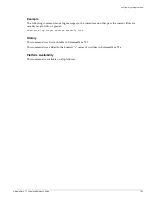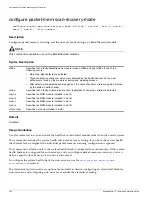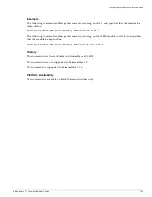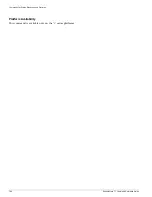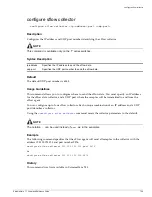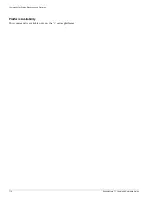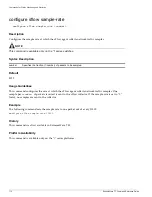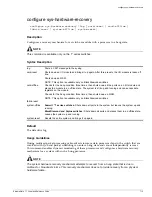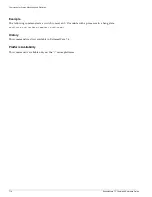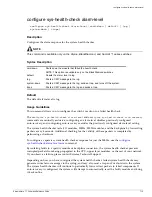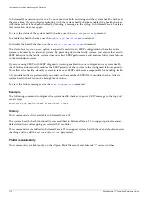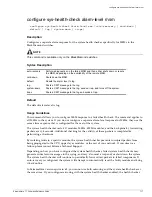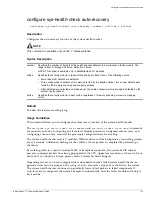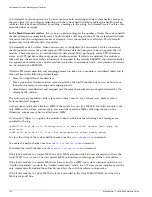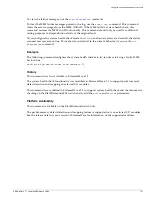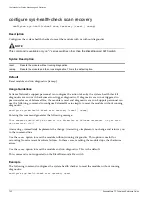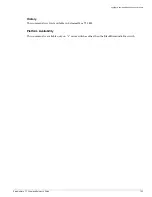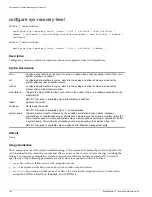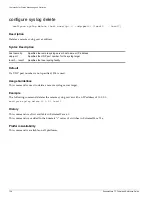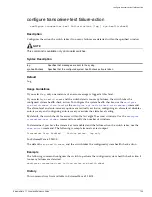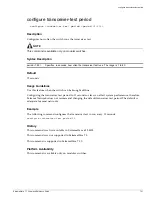
716
ExtremeWare 7.7 Command Reference Guide
Commands for Status Monitoring and Statistics
In ExtremeWare versions prior to 6.2, you cannot use both mirroring and the system health checker at
the same time. If you configure mirroring with the system health checker enabled, the health checker
will indicate that it has been disabled by sending a message to the syslog. In ExtremeWare 6.2 or later,
this restriction does not apply.
To view the status of the system health checker, use the
show diagnostics
command.
To enable the health checker, use the
enable sys-health-check
command.
To disable the health checker, use the
disable sys-health-check
command.
The alarm-level
system-down
option is especially useful in an ESRP configuration where the entire
system is backed by an identical system. By powering down the faulty system, you ensure that erratic
ESRP behavior in the faulty system does not affect ESRP performance and ensures full system failover
to the redundant system.
If you are using ESRP with ESRP diagnostic tracking enabled in your configuration, a system health
check failure automatically reduces the ESRP priority of the system to the configured failover priority.
This allows the healthy standby system to take over ESRP and become responsible for handling traffic.
I/O module faults are permanently recorded on the module’s EEPROM. A module that has failed a
system health check cannot be brought back online.
To view the failure messages, use the
show diagnostics
command.
Example
The following command configures the system health checker to post a CRIT message to the log and
send a trap:
configure sys-health-check alarm-level traps
History
This command was first available in ExtremeWare 6.1.9.
The system health check functionality was modified in ExtremeWare 6.2.1 to support packet memory
defect detection and mapping on selected I/O modules.
This command was modified in ExtremeWare 6.2.2 to support system health check and checksum error
checking and to add the
online
and
offline
parameters.
Platform Availability
This command is available only on the Alpine, BlackDiamond, and Summit “
i
” series switches.
Summary of Contents for ExtremeWare 7.7
Page 60: ...60 ExtremeWare 7 7 Command Reference Guide Contents ...
Page 72: ...72 ExtremeWare 7 7 Command Reference Guide Command Reference Overview ...
Page 404: ...404 ExtremeWare 7 7 Command Reference Guide VLAN Commands ...
Page 472: ...472 ExtremeWare 7 7 Command Reference Guide QoS Commands ...
Page 492: ...492 ExtremeWare 7 7 Command Reference Guide NAT Commands ...
Page 890: ...890 ExtremeWare 7 7 Command Reference Guide Security Commands ...
Page 1130: ...1130 ExtremeWare 7 7 Command Reference Guide Security Commands ...
Page 1164: ...1164 ExtremeWare 7 7 Command Reference Guide Configuration and Image Commands ...
Page 1436: ...1436 ExtremeWare 7 7 Command Reference Guide Wireless Commands ...
Page 1490: ...1490 ExtremeWare 7 7 Command Reference Guide EAPS Commands ...
Page 1576: ...1576 ExtremeWare 7 7 Command Reference Guide ESRP Commands ...
Page 1774: ...1774 ExtremeWare 7 7 Command Reference Guide IP Unicast Commands ...
Page 1914: ...1914 ExtremeWare 7 7 Command Reference Guide IGP Commands ...
Page 2000: ...2000 ExtremeWare 7 7 Command Reference Guide BGP Commands i Series Switches Only ...
Page 2140: ...2140 ExtremeWare 7 7 Command Reference Guide IPX Commands i Series Platforms Only ...
Page 2156: ...2156 ExtremeWare 7 7 Command Reference Guide ARM Commands BlackDiamond Switch Only ...
Page 2168: ...2168 ExtremeWare 7 7 Command Reference Guide Remote Connect Commands ...
Page 2346: ...2346 ExtremeWare 7 7 Command Reference Guide PoS Commands BlackDiamond Switch Only ...
Page 2446: ...2446 ExtremeWare 7 7 Command Reference Guide LLDP Commands ...
Page 2496: ...2496 ExtremeWare 7 7 Command Reference Guide H VPLS Commands BlackDiamond Switch Only ...
Page 2620: ...2620 ExtremeWare 7 7 Command Reference Guide Index of Commands ...


